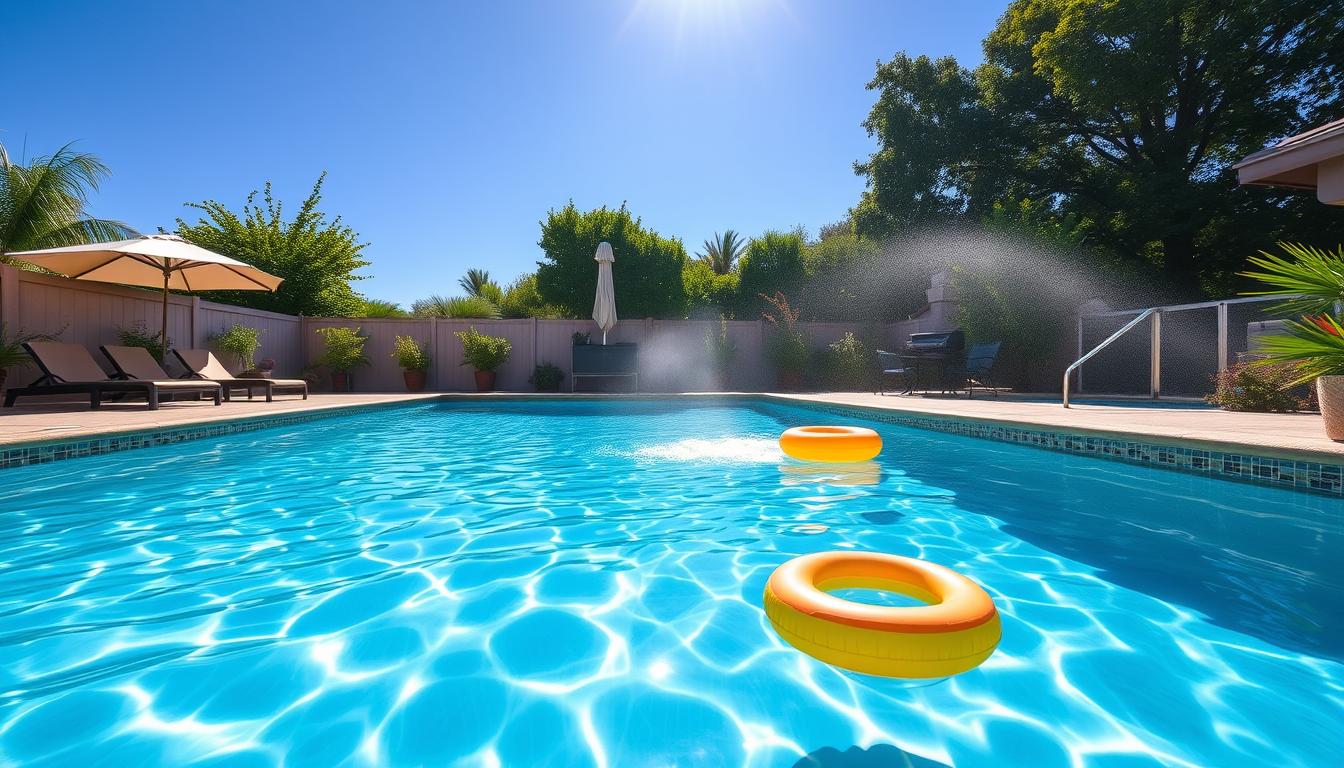
Hot summers can make pool water uncomfortably warm. Keeping your pool cool is crucial for a refreshing swim. Let’s explore expert tips to maintain an inviting pool temperature.
We’ll cover effective cooling methods for your pool. These include shading options and advanced tech solutions. Our guide will help you create a relaxing oasis in your backyard.
Energy-efficient cooling can reduce water temps and save power. We’ll discuss evaporative coolers, chillers, and smart heat management. Pool insulation benefits will also be explored.
Key Takeaways
- Implement effective pool cooling techniques to maintain a comfortable water temperature during summer
- Utilize strategic shading options, such as trees, pergolas, and shade sails, to reduce heat absorption
- Explore technological solutions, including pool chillers and reversible heat pumps, for efficient temperature regulation
- Incorporate regular pool maintenance practices to prevent algae growth and maintain proper water circulation
- Consider pool insulation strategies to minimize heat transfer and maintain cooler water temperatures
Understanding Pool Water Temperature Dynamics
Creating the perfect swimming environment involves maintaining optimal pool water temperature. Understanding temperature factors and measurement methods ensures a comfortable swimming experience. Let’s explore how to achieve this for your pool.
Factors Influencing Pool Water Temperature
Weather conditions significantly impact pool water temperature. Direct sunlight exposure plays a crucial role in warming the water. Pools with full sun exposure are naturally warmer than those with less sunlight.
Pool size and depth also affect temperature. Shallower pools warm up faster due to their larger surface area exposed to sunlight. This allows for better heat transfer from the sun to the water.
Other factors influencing pool temperature include water circulation, wind, and humidity levels. These elements can affect how warm or cool your pool water becomes.
| Factor | Impact on Pool Water Temperature |
|---|---|
| Direct Sunlight | Pools exposed to more sunlight tend to be warmer |
| Pool Depth | Shallower pools warm up faster than deeper pools |
| Water Circulation | Proper circulation helps distribute heat evenly |
| Wind | Wind can enhance evaporation and cool the water |
| Humidity | Higher humidity levels can slow down evaporation |
Measuring Pool Water Temperature
Accurate temperature measurement is vital for a balanced swimming environment. Various methods exist, from basic digital thermometers to advanced systems integrated into pool filtration.
Choose a reliable and accurate measurement method for informed temperature regulation decisions. This helps provide a pleasant swimming experience for all pool users.
Regular monitoring alerts you to unusual fluctuations that may indicate heating or cooling system issues. Staying on top of temperature changes ensures a consistently enjoyable pool.
“Accurate pool temperature measurement is key to ensuring a comfortable and enjoyable swimming experience for all.”
By grasping temperature factors and using effective measurement techniques, you’ll create an ideal swimming environment. Your loved ones can enjoy the pool throughout summer with perfect water temperatures.
Effective Strategies to Cool Your Pool
Pool owners seek ways to keep water comfortable during hot summer months. In Houston, temperatures often reach 100 degrees or higher. Let’s explore methods to maintain optimal water temperatures between 80-90 degrees.
Utilize Shade to Reduce Heat Absorption
Creating shaded areas around your pool naturally cools the water. Installing offset umbrellas can lower water temperature by about 6 degrees. Other options include planting trees, installing pergolas, or using sail cloths.
When choosing trees, consider their leaf drop and root system. This ensures they’re suitable for the pool area.
Incorporate Water Features for Natural Cooling
Adding fountains, waterfalls, or sprayers helps lower water temperature naturally. As water circulates through these features, it mixes with cooler air. This process cools the pool’s surface water, maintaining comfort for swimmers.
Explore Technological Solutions: Pool Chillers and Reversible Heat Pumps
Pool cooling technology offers advanced solutions for regulating water temperature. Pool chillers and reversible heat pumps extract heat from water and transfer it to air. These systems cost between $5,000 and $10,000 but provide reliable, efficient cooling.
| Cooling System | Cost Range | Potential Temperature Decrease |
|---|---|---|
| Reversible Heat Pumps | $8,000 – $10,000 | 5-10 degrees |
| Evaporative Coolers | $5,000 – $7,000 | 5-10 degrees |
Implement Regular Pool Maintenance Practices
Regular pool maintenance is crucial for optimal water temperature. Proper upkeep ensures consistent, comfortable water for swimming. Essential practices include cleaning debris and monitoring pH levels.
- Regular cleaning and clearing of debris
- Monitoring pH levels
- Maintaining proper chemical balance to prevent algae growth
- Annual maintenance for cooling systems, such as hosing off evaporative coolers at the end of summer and covering them during winter
Glacier Pool Coolers utilize an electric fan and pump to cool water using misting within the unit, requiring 120V AC and no Freon, gas, or heat exchanger to operate. Models GPC-23 and GPC-25 require a 2 X 2 pad for installation, while GPC-210 demands a 3 X 3 pad.
These strategies help maintain a comfortable pool temperature. Proper implementation ensures an enjoyable swimming experience throughout summer. Regular maintenance keeps your pool refreshing and inviting all season long.
Conclusion
Keeping your pool cool in summer requires effective solutions and expert care. Shade, water features, and pool chillers can help regulate temperature. Regular maintenance and proper water chemistry are crucial for a clean, safe pool.
Professional pool services offer tailored advice for your specific needs. They consider factors like location, size, and usage. Their recommendations can help create ideal swimming conditions.
During heat waves, pay extra attention to water chemistry and circulation. Test the water often and maintain chlorine levels between 1-4 ppm. Enhance your algae prevention routine to keep the pool clean.
With expert advice and proper maintenance, your pool can be a refreshing retreat. You’ll create a comfortable swimming experience for everyone to enjoy. Transform your pool into a cool oasis during hot summer days.







